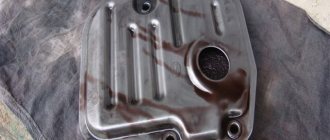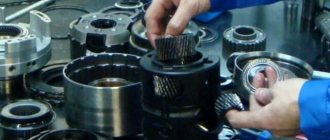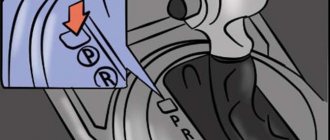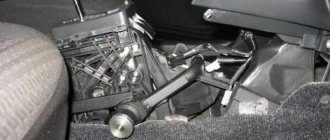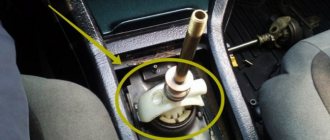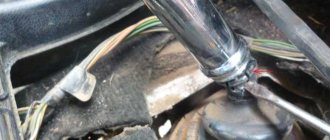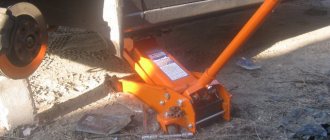Cars with automatic transmissions are in great demand today, both among novice drivers and experienced car owners with extensive experience.
First of all, an automatic transmission greatly simplifies the process of driving a vehicle. Also, automatic transmission provides a high level of comfort and increases safety in heavy traffic conditions in dense city traffic.
At the same time, the automatic transmission itself is a complex unit, with which many problems often arise. As a rule, the most common breakdown of cars with automatic transmission is noticeable jolts when switching the automatic transmission in place or while moving. Let's look at the main reasons for their appearance.
Common Causes
When the first signs appear, car owners seek answers from experts to the question “why does the automatic transmission jerk in the car?” Experienced service station employees will not immediately determine the cause. It is necessary to test the vehicle for the presence of errors in the ECU or other malfunctions.
Attention! The AL4 (DP0) automatic transmission from the French concern Peugeot-Citroen will always twitch with small, rare vibrations when changing gears. This is a manufacturer's defect that has not been corrected.
Shocks due to late oil change
The lubricant plays a major role in the operation of the automatic transmission. The box will twitch if the car owner:
- does not check the quality of the lubricant. Due to overheating and wear of mechanical parts that mix with the liquid, the oil quickly loses viscosity and does not perform its intended functions. In this case, the automatic transmission will jerk when moving from second to third speed;
- fills in oil from another company that does not meet the standard for the automatic transmission into which it was poured. This happens when a beginner fills in lubricant from another company. Each lubricant is manufactured in accordance with the requirements for certain automatic transmissions.
Attention! The lubricant must be completely replaced after a mileage of 60,000 kilometers and partially after 30 thousand km. Check the lubricant level every ten thousand kilometers.
Automatic transmission jerking will appear when starting in cold weather in the winter season. Cold butter has a thick consistency. It is not capable of becoming plastic in ten seconds. Lubricant will not enter the channels and close and open the valves quickly enough. This means that the torque transmitted by the transmission fluid inside the torque converter will be delayed.
Read
12 inexpensive cars with automatic transmission
Experts recommend warming up the car and automatic transmission before driving. If there is a sensor on the car dashboard monitor that shows the temperature of the automatic transmission, then it is advisable to wait until it rises to 60 degrees Celsius.
Oil filter
Shocks when switching in an automatic transmission occur due to a dirty filter. This is a device that cleans fluid from wear products of mechanical parts.
Over time, the filter accumulates:
- soot, which contains glue from friction linings;
- chips from wear of metal parts.
It is not capable of passing transmission fluid in the amount that the machine needs for optimal functioning.
Shocks due to low oil level
The machine jerks because the car owner does not check the oil level. Lubricant is produced over time and leaks out in places where there is no tightness in the connections or where the seals dry out. As a result, the lubricant level decreases.
As the ATF level decreases, the pressure in the box drops. Mechanical gears and valves, the operation of which directly depends on the stability of pressure in the hydraulics, slip, jump from one to another and the box jerks.
Friction discs
Friction discs are gears that mesh together using teeth to transmit torque and grip. Over time, the gaps between the disc teeth increase. The larger the gap, the longer it will take for the clutch to engage and start the next gear. If the teeth in one of the clutch packs have become unusable, then the automatic transmission will ignore this speed when changing automatic transmission gears.
Read
Automatic transmission aisin A340E AW 30-40LE: oil change and valve body maintenance
The driver usually feels this malfunction as a jolt when the car picks up speed. For example, on a Mazda 6 built before 2009, the driver felt a noticeable jolt when shifting from 3rd to 4th gear. When a Mazda automatic transmission jerks, this indicates wear on the brake band mounting rod on this particular model.
Valve block and valves solenoids
Automatic transmission shocks when switching appear when the valve body solenoids fail. For example, on French automatic models DP0 the oil pressure control valve suffers the most.
The solenoids do not block the channels or, on the contrary, do not open them. The lubricant does not function freely throughout the box. The speeds do not change or do so with a slowdown. The driver feels the machine twitching.
In machines manufactured after 2000, the solenoid housing is made of plastic. Therefore, after a slight overheating of the box in the hot season, the valve solenoids melt and can no longer perform their functions. The gearbox will also jerk.
Electronics
The transmission ECU has the fewest problems. The wires of the electronic control unit break or are torn as a result of mechanical damage. The contacts are oxidized. Signals from the electronic unit are lost and the valves do not open on time or do so with delay.
The driver may notice shocks when switching the automatic transmission if the ECM sensors fail. The electronic control unit of the machine itself rarely breaks down.
Mercedes from the 722.9 series are equipped with seven-speed GMT6T30 automatic transmissions, and on six-speed automatic transmissions of the same model there is an electronic board on the pallet. It's called mechatron. Controls valves with solenoids. The failure of this board can also be signaled to the driver by jerks and jerks of the gearbox.
Read
The design and principle of operation of the automatic transmission torque converter
Liquid cooling radiator
It happens that the automatic transmission only jerks when it’s hot. This indicates that the cooling radiator is not doing its job. As a result, the oil overheats and the lubricant curdles. There is an additional load on the device.
The radiator may not cope with cooling due to the fact that it is clogged with dirt from the outside or inside. Mechanical damage to the pipes and pinches affect the stable circulation of oil through the cooling device.
Gear shift rules
I’ll immediately give you the basic rule of HOW to change gears correctly: you need to change gears correctly so that the car moves as smoothly as possible, and people in the cabin do not feel any pecks, jerks and jolts during the shifting moments . And don't believe it when they say it's impossible to shift smoothly at high engine speeds or during heavy acceleration. Can! If one of your friends who claims this, the car jerks when switching - even at high speeds, even with the gas to the floor - advise him to change the gasket. Between the steering wheel and the seat, of course . Although this does not necessarily indicate a low level of driving skill, it is quite possible that a person knows how to shift smoothly, he just doesn’t bother.
And don't believe it when they say it's impossible to shift smoothly at high engine speeds or during heavy acceleration. Can! If one of your friends who claims this, the car jerks when switching - even at high speeds, even with the gas to the floor - advise him to change the gasket. Between the steering wheel and the seat, of course . Although this does not necessarily indicate a low level of driving skill, it is quite possible that a person knows how to shift smoothly, he just doesn’t bother.
And one more rule about WHEN to change gears: it is correct to change gears not by the speedometer, not by the noise of the engine, and not by the swearing of a driving instructor or passenger sitting next to you, but guided by the tachometer readings . Let me remind you that the driver changes gears to change engine speed and obtain the desired driving characteristics . For more information about the tachometer and its readings, read the article “Engine Torque”. And here I will limit myself to specific values and recommendations: at what tachometer readings should one or another gear be engaged.
Diagnostics and solutions
You can diagnose why the automatic transmission jerks when shifting using several methods:
- testing the vehicle while driving;
- testing on a stopped vehicle;
- test for the quality of the liquid and its level in the machine;
- hydraulic system test;
- testing the ECU for faults.
The automatic transmission test did not show any faults in it, but the box continues to jerk; you should check how the engine operates at high and low speeds. The motor components may be faulty.
Checking the automatic transmission shows that errors have been detected in the machine, then the following instructions will help the car owner correct them.
Jerks when accelerating
When moving forward, when the car picks up speed, the automatic transmission may jerk due to problems with mechanical components.
Causes
One of these reasons is the failure of clutch packs. The gear teeth have become unusable and slip when the torque transmission changes and increases.
Another reason is overpressure or low pressure on the gas pedal. For example, a newbie got behind the wheel of a vehicle he had just purchased. The ECU is accustomed to the driving style of the previous owner. Therefore, the automatic will twitch and kick, adapting to the new driver.
Solution
If the teeth of the automatic transmission clutches are worn out, then experts recommend installing new disc packages. If the problem is with the new driver, then you need to wait some time until the automatic transmission stops twitching and adapts to the car owner’s driving style. Or conduct an adaptation course for the machine:
- Start the car, warm it up, turn off and start the engine again. Do several repetitions.
- Apply the brake. Switch the machine to manual control. Include modes and gears in the order in which they will be used in the future.
- Start, accelerate smoothly to 40 km/h, turn off. Repeat the same steps again, only accelerate to 80 km/h.
- Repeat point No. 3 and drive 10 kilometers.
Read
What to do if the automatic transmission kicks
Kicks hot or cold
The machine twitches when accelerating, and also twitches slightly when starting cold or hot, when:
- the box is not warmed up;
- clogged filter device;
- hydraulic unit is clogged.
Causes
If the automatic transmission jerks when it is not warmed up, then for many automatic transmissions these jerks are the norm. Oil is thick and cannot fully perform its functions. Jerking when hot indicates unstable operation of the valve body valves, loss of pressure due to blockages or poor-quality lubricant.
Solution
The automatic transmission must be warmed up before driving, both in winter and summer. When twitching hot, experts recommend checking the quality of the lubricant. Replace when the lubricant turns black and impurities of wear products of mechanical parts appear. Replace the filter device.
Along with changing the oil, you need to remove and clean the valve body. Since the fumes accumulated in the holes for the valves will prevent them from working properly. Then the automatic transmission will stop jerking and pushing.
Shocks when switching
The automatic transmission jerks when the driver moves the gear shifter to position “d” in cases where:
- the hydraulic plate has broken down;
- Friction discs wear out.
When the car slows down, the automatic transmission jerks due to faulty solenoids. Details in the next block.
Read
Automatic transmission and trailer, or is it possible to haul a trailer with an automatic transmission?
Causes
Shocks in the machine cause damage to the valve body due to the age of the device or contamination of the channels where the lubricant circulates. The teeth on the friction discs grind down and the gaskets burn. Shocks when braking indicate wear on the brake band.
Blockages lead to the lubricant becoming enriched with wear products. If the problem is not resolved in time, it will lead to the replacement of the entire automatic transmission.
Solution
You will have to completely disassemble the box and completely repair the hydraulic plate. Experienced mechanics at the service center can make high-quality repairs. If the car owner understands how the box works and how it is structured, then experts do not recommend solving this problem on their own.
The friction discs and brake band will need to be replaced.
Vibration when rear is engaged
Sometimes the box jerks when you engage reverse gear. You will need to test the automatic transmission using a computer.
Causes
The sensor has broken or the hydraulic converter has failed. The fluid coupling may have broken.
Solution
Go to a service station, install it on a testing stand, and experienced mechanics will carry out testing. If the sensor breaks, it will be replaced. If you need to repair the torque converter, you will have to cut it on a machine. Therefore, it is better not to do this procedure at home.
Impact of jerks on the car
Communities VAZ Repair and Modification Blog VAZ 21124 engine troubles, stalls, jerks when sharply pressing the gas pedal problem solution
Whether jerking the car is beneficial or harmful is a rhetorical question. It’s the same as poking a person with a knife and asking if your health is improving. Any kind of jerking of the car is harmful, be it just a jolt when driving or a consequence of changing gears.
The main impact falls on the transmission unit and the engine part. First of all, the load on moving elements (bearings, switches, gears) increases. Each impact can deform, leave a crack or completely break any of these elements. Repairs can take a long time and cost the car owner a significant amount of money.
That is why it is important to initially determine the reason why the car began to twitch and eradicate it
I checked all the reasons - it didn’t help
If the car owner has fully diagnosed the automatic transmission, and the box jerks, then you need to look for faults in other components of the vehicle:
- low quality fuel;
- problems with the battery or starting system;
- the problem is in the engine.
Attention! In order to correctly diagnose why the automatic transmission is not working stably, you need to have special equipment on hand.
